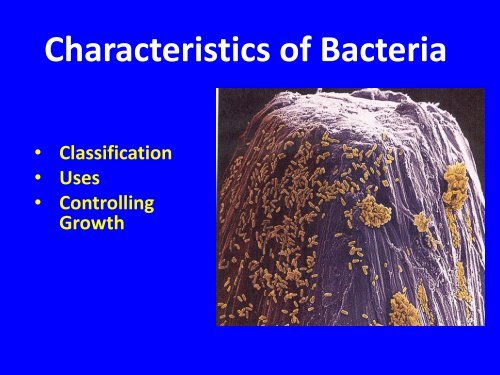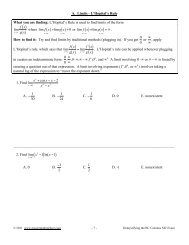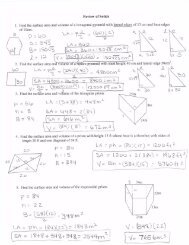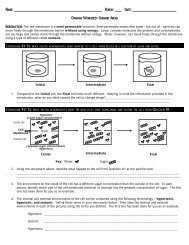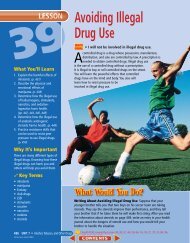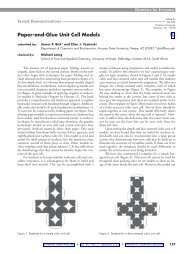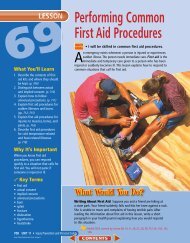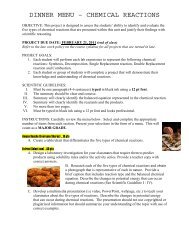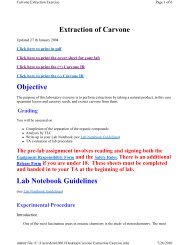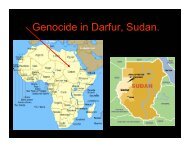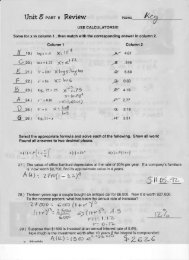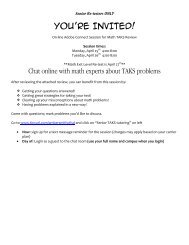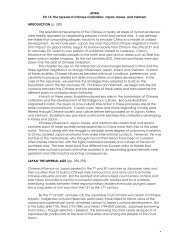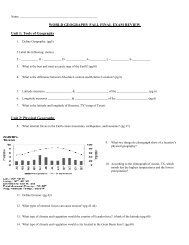Characteristics of Bacteria
Characteristics of Bacteria
Characteristics of Bacteria
Create successful ePaper yourself
Turn your PDF publications into a flip-book with our unique Google optimized e-Paper software.
<strong>Characteristics</strong> <strong>of</strong> <strong>Bacteria</strong><br />
• Classification<br />
• Uses<br />
• Controlling<br />
Growth
Structure <strong>of</strong> <strong>Bacteria</strong><br />
• Two parts to <strong>Bacteria</strong> Structure:<br />
–Arrangement<br />
–Shape
3 Shapes <strong>of</strong> <strong>Bacteria</strong><br />
<strong>Bacteria</strong> are classified by shape into 3 groups:<br />
Spiral:<br />
spirilla, spirillum<br />
Rod-shaped:<br />
bacilli, bacillus<br />
Round:<br />
cocci, coccus<br />
3
• Rod: bacillus<br />
• Round: coccus<br />
Shape<br />
• Spiral: spirillum
<strong>Bacteria</strong> Arrangement<br />
• Paired: diplo<br />
• Grape-like clusters: staphylo<br />
• Chains: strepto
Examples<br />
• Streptococcus: chains <strong>of</strong> spheres<br />
• Staphylospirillum: Grapelike<br />
clusters <strong>of</strong> spirals<br />
• Streptobacillus: Chains <strong>of</strong> rods
Name these bacteria…
Harmful <strong>Bacteria</strong><br />
• some bacteria cause diseases<br />
•Animals can pass diseases to humans<br />
Communicable Disease –<br />
Disease passed from one organism to another<br />
This can happen in several ways:<br />
•Air<br />
•Touching clothing, food, silverware, or toothbrush<br />
•Drinking water that contains bacteria<br />
8
Harmful <strong>Bacteria</strong><br />
Human tooth with accumulation <strong>of</strong> bacterial<br />
plaque (smooth areas) and calcified tartar<br />
(rough areas)<br />
9
Helpful <strong>Bacteria</strong><br />
•Decomposers help recycle nutrients into the<br />
soil for other organisms to grow<br />
•<strong>Bacteria</strong> grow in the stomach <strong>of</strong> a cow to<br />
break down grass and hay<br />
•Most are used to make antibiotics<br />
•Some bacteria help make insulin<br />
•Used to make industrial chemicals<br />
10
Helpful <strong>Bacteria</strong><br />
•Used to treat sewage<br />
Organic waste is consumed by the bacteria,<br />
used as nutrients by the bacteria, and is no<br />
longer present to produce odors, sludge,<br />
pollution, or unsightly mess.<br />
•foods like yogurt, cottage & Swiss cheese,<br />
sour cream, buttermilk are made from bacteria<br />
that grows in milk<br />
11
Helpful <strong>Bacteria</strong><br />
E.coli on small intestines<br />
12
Controlling <strong>Bacteria</strong><br />
3 ways to control bacteria:<br />
1) Canning- the process <strong>of</strong> sealing food in<br />
airtight cans or jars after killing bacteria<br />
•endospores are killed during this process<br />
2) Pasteurization- process <strong>of</strong> heating milk<br />
to kill harmful bacteria<br />
3) Dehydration- removing water from food<br />
•<strong>Bacteria</strong> can’t grow when H 2O is removed<br />
•example: uncooked noodles & cold cereal<br />
13
Controlling <strong>Bacteria</strong> in People<br />
Antibiotics = inhibit bacterial growth;<br />
stop reproduction or kill<br />
-directly kill or inhibit the bacteria<br />
(Drugs that inhibit viruses are usually<br />
called anti-virals.)<br />
Immunization = inject parts <strong>of</strong> bacteria<br />
or viruses to “train” the immune<br />
system to destroy the pathogen<br />
-make a person’s body uninhabitable for<br />
the bacteria OR viruses
Penicillium Fungus


